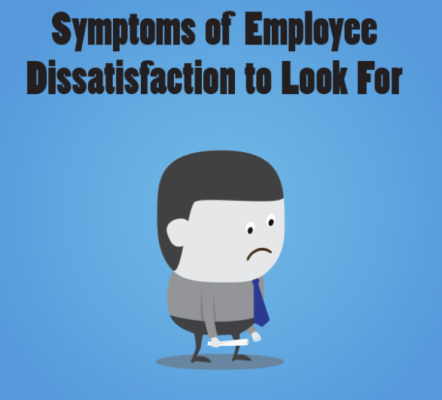Many employers mistakenly believe that insufficient salary is the source of all workplace woes. And while some workers certainly opt to move on for better wages and benefits, the surprising truth is that 88% of employees leave a company for reasons unrelated to income. In fact, employee dissatisfaction can stem from a wide variety of causes, including stressful work responsibilities, lack of opportunity and even poor relationships with co-workers.
By familiarizing themselves with the warning signs of employee dissatisfaction, companies can avoid being blindsided when workers quit and perhaps even deal with problems before they arise.
Common Red Flags
Missing Work
Wondering if your workers are happy on the job? If employees are calling in sick with greater frequency, there’s a strong chance that they’re less than thrilled in their current careers. Unhappy employees may also take extra-long lunches to attend interviews, an action that can upset other workers who must then scramble to cover for their missing colleagues.
If your employee is demonstrating increased tardiness, consider asking him or her if anything is wrong. However, you should take care not to jump to any conclusions, since absenteeism can indicate personal issues rather than professional ones. Consistent communication is key to discovering the true source of the problem and, if possible, correcting it.
Poor Productivity
Is your formerly efficient worker demonstrating less productivity than usual? Reduced employee output is a strong indicator of unhappiness in the workplace. In some cases, dissatisfied employees lessen their efforts and turn their attention to finding other jobs.
In other instances, workers may experience problems in the office—like conflicts with co-workers—that prevent them from performing, so it’s important to talk through any problems that arise. Remember, if you’re noticing lots of errors, there’s a good chance your customers will soon notice them as well. Talk to your poorly performing employee to find out if there’s anything you can do to correct the problem before one of you opts to end the relationship.
Airing Grievances
Every employee expresses dissatisfaction or disagreement from time to time. However, if some of your workers are continually airing their grievances in the office or to other co-workers, it may be a sign that they are considering moving on to more satisfying positions (or to a company that follows a path they agree with).
Pay attention to what your employees are saying both to your face and behind your back to avoid being surprised—and inconvenienced—when people suddenly quit.
Less Obvious Signs of Discontent
While poor productivity and airing one’s grievances in public are relatively common signs of employee dissatisfaction, there are also a number of less obvious signs that indicate your workers are displeased in their current roles. Look out for the following signs that may suggest your employee might be thinking of quitting:
Socializing Less
Is your formerly gregarious employee no longer showing up for work lunches or happy hours? Dissatisfied workers are less likely to socialize or make casual conversation with their co-workers and supervisors. If you notice that an employee is pulling away from the rest of the team, consider asking if anything is wrong.
You may be able to draw your worker back into the fold by offering new opportunities for advancement or even a well-deserved raise. If you can’t stop your employee from leaving, you may at least get a heads-up on the upcoming vacancy so you can start searching for someone to fill the spot.
Not Sharing Ideas
When your most creative and vocal employee suddenly becomes a yes-man (or -woman), it could indicate that he or she is thinking of leaving the company. Workers who are less than satisfied tend to go with the flow rather than take part in the creative process.
Keep in mind that some employees may be more naturally inclined towards following your lead, and for these more introverted individuals, being silent during meetings doesn’t necessarily mean they are not engaged. However, if formerly outspoken employees seem to be taking a backseat during discussions and planning, consider asking them if there’s anything on their mind.
Addressing Employee Dissatisfaction
If you’ve discovered that one or more of your best employees are thinking of quitting, it’s important that you don’t lose hope. Savvy employers can take steps to boost workplace happiness and avoid high turnover.
Although it sounds obvious, good communication is an essential element of employee retention. Just make sure that you are both talking and listening in these discussions so employees have the opportunity to express their concerns. When trying to fix a problem, invite the employee to make suggestions as well. With a little luck, you can find a solution that will both improve your worker’s happiness and increase productivity for the company as a whole.
If you notice that many of your employees seem unmotivated, you may want to consider implementing a reward system to encourage them. While monetary rewards like bonuses are always appreciated, studies show that employees respond even better to positive reinforcement, attention from their superiors and the opportunity to take ownership of projects.
Show all of your workers that you appreciate their hard work, and single people out for particular achievements. A kind word in the elevator or quick congratulatory email can do a great deal to show your workers that they’re valued members of the team. Small changes can make a big difference when it comes to preventing employees from getting restless.
Don’t Lose Your Best Assets to the Competition
It’s hard for a company to succeed if its most effective employees are always leaving to pursue other opportunities. Unfortunately, many supervisors have trouble determining whether or not their workers are happy. Don’t be afraid to meet with a worker one-on-one or to schedule a business lunch to discuss potential issues.
Staying alert to the symptoms of employee dissatisfaction and taking steps to address problems can help prevent high turnover while ensuring that your company continues to thrive in the coming years.




